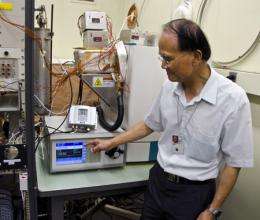New point for dew point

Peter Huang of the Sensor Science Division’s Temperature and Humidity group has devised a new humidity generator that enables dew-point measurements up to 98 °C – a substantial extension above the previous limit of 85 °C – and provides expanded calibration services for hygrometers in a variety of industries.
With summer coming on, some people might not regard an improved humidity generator as an urgent priority. But “water vapor – steam – is in fact the most critical element in modern industrial bakeries,” Huang says. “The baking process consists of a number of physical, biochemical, and chemical processes tied to quite narrow humidity and temperature ranges. The energy in an oven must reach the baked goods, for example Kaiser rolls, in exactly the required form. Too much humidity means enormous energy consumption. But too little humidity can cause the dough’s surface to dry prematurely, resulting in cracked and dull crusts and forcing the company to discard the product.”
Controlling temperature and humidity are also essential to holding down costs, because much of the thermal energy is wasted. “Studies show that only about 25 % of the consumed energy is utilized for the baked goods,” Huang says. “As for the rest, 4 % is lost through radiation and convection in a well-constructed oven. Approximately 27 % is contained in the exhaust gas, and 44 % in the water vapor.
“For example, a tunnel oven 80 feet long by 12 feet wide may produce 250,000 Kaiser rolls in a day. The oven uses 6 million BTU of heat per hour, fired by gas or oil. To achieve maximum product quality with minimum energy consumption, accurate measurement and control of oven humidity are needed in the range of mole fraction of water vapor from 0.5 to 0.95 and temperatures of 100 °C to 200 °C.”
To meet those and other needs, Huang and colleagues developed the new “Multi-Gas Humidity Generator,” so called because it can be used to produce water vapor in nitrogen, air, hydrogen, methane, and other gases. It can be used to produce air streams of known moisture content with water-vapor mole fraction levels of 0.5 to 0.95, which correspond to a range of dew-point temperatures from 85 °C to 98 °C at 1 atmospheric pressure, with only a modestly expanded uncertainty (approximately 95 % confident level) of 0.05 °C.
In addition, Huang says, “this new NIST capability, which extends the current limit of 85 °C dew point produced by the current standard, the Hybrid Humidity Generator, can also benefit the fuel cell industry. High-level humidity measurement and control are crucial for testing and optimization of hydrogen fuel cells.”
Provided by National Institute of Standards and Technology



















